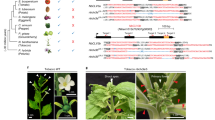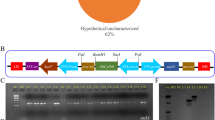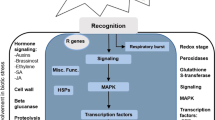Abstract
Chimeric isopentenyl transferase (ipt) gene constructs were prepared and introduced into tomato plants via Agrobacterium-mediated transformation. Expression of the ipt gene, which encodes a key enzyme involved in the biosynthesis of the plant growth regulator cytokinin, was modulated using a promoter from a gene expressed primarily in tomato ovaries. As expected, the ipt gene was expressed, and levels of cytokinin were increased, in ovaries of the transgenic plants. Plant yield and fruit processing characteristics of these transgenic plants were examined during three consecutive years of field testing. Levels of total solids were significantly increased in six of seven, and soluble solids were significantly increased hi five of seven, independent transgenic tomato lines.
This is a preview of subscription content, access via your institution
Access options
Subscribe to this journal
Receive 12 print issues and online access
$259.00 per year
only $21.58 per issue
Buy this article
- Purchase on SpringerLink
- Instant access to full article PDF
Prices may be subject to local taxes which are calculated during checkout
Similar content being viewed by others
References
Rick, C.M. 1974. High soluble-solids content in large-fruited tomato lines from a wild green-fruited species. Hilgardia 42: 493–510.
Davies, J.N. and Hobson, G.E. 1981. The constituents of tomato fruit—the influence of environment, nutrition and genotype. CRC Crit. Rev. Food Sci. Nutr. 15: 205–280.
Stevens, M.A., Kader, A.A. and Albright-Holton, M. 1997. Intereultivar variation in composition of locular and pericarp portions of fresh market tomatoes. J. Amer. Soc. Hort. Sci. 102: 689–692.
Hewitt, J.D., Dinar, M. and Stevens, M.A. 1982. Sink strength of fruits of two tomato genotypes differing in total fruit solids content. J. Amer. Soc. Hort. Sci. 107: 896–900.
Gersani, M. and Lips, S.H. 1980. The influence of shoots, roots, and hormones on sucrose distribution. J. Expt. Biol. 31: 177–184.
Leonard, M., Kinet, J.-M., Bodson, M. and Bernier, G. 1983. Enhanced inflorescence development in tomato by growth substance treatments in relation to 14C-assimilate distribution. Physiol. Plant. 57: 85–89.
Thomas, T.H. 1985. Hormonal control of assimilate movement and compart-mentation, p. 350–359. In: Plant Growth Substances. Bopp, M. (Ed.). Springer-Verlag Berlin.
Lenton, J.R. 1984. Are plant growth substances involved in the partitioning of assimilate to developing reproductive sinks? Plant Growth Regulation 2: 267–276.
Martineau, B. and Houck, C.M. 1992. Ovary-tissue transcriptional factors. U.S. patent no. 5,175,095.
Martineau, B., McBride, K.E. and Houck, C.M. 1991. Regulation of metallo-carboxypeptidase inhibitor gene expression in tomato. Mol. Gen. Genet. 228: 281–286.
Sambrook, J., Fritsch, E.F. and Maniatis, T. 1989. Molecular Cloning: A Laboratory Manual. Cold Spring Harbor Laboratory Press, Cold Spring Harbor, New York.
Martineau, B., Houck, C.M., Sheehy, R.E. and Hiatt, W.R. 1994. Fruit-specific expression of the A. tumefaciens isopentenyl transferase gene in tomato: effects on fruit ripening and defense-related gene expression in leaves. Plant J. 5: 11–19.
Barker, R.F., Idler, K.B., Thompson, D.V. and Kemp, J.D. 1983. Nucleotide sequence of the T-DNA region from the Agrobacterium tumefaciens octopine Ti plasmid pTi15955. Plant Mol. Biol. 2: 335–350.
McBride, K.E. and Summerfelt, K.R. 1990. Improved binary vectors for Agrobacterium-mediated plant transformation. Plant Mol. Biol. 14: 269–276.
Redenbaugh, K., Hiatt, W., Martineau, B., Kramer, M., Sheehy, R., Sanders, R., Houck, C. and Emlay, D. 1992. Safety assessment of genetically engineered fruits and vegetables: A case study of the Flavr Savr™ Tomato. CRC Press, Boca Raton.
Crosby, K.E., Aung, L.H. and Buss, G.R. 1981. Influence of 6-benzylamino purine on fruit-set and seed development in two soybean, Glycine max (L.) Merr. genotypes. Plant Physiol. 68: 985–988.
Carlson, D.R., Dyer, D.J., Cotterman, C.D. and Durley, R.C. 1987. The physiological basis for cytokinin induced increases in pod set in IX93-100 soybean. Plant Physiol. 84: 233–239.
Peterson, C.M., Williams, J.C. and Kuang, A. 1990. Increased pod set of determinate cultivars of soybean, Glycine max, with 6-benzylaminopurine. Botanical Gazette 151: 322–330.
Rylott, P.D. and Smith, M.L. 1990. Effects of applied plant growth substances on pod set in broad beans (Vicia faba var. major). J. Agric. Sci., Cambridge 114: 41–47.
Atkins, C.A. and Pigeaire, A. 1993. Application of cytokinins to flowers to increase pod set in Lupinus angustifolius L. Aust. J. Agric. Res. 44: 1799–1819.
Ho, L.C. 1984. Partitioning of assimilates in fruiting tomato plants. Plant Growth Regulation 2: 277–285.
Ho, L.C. and Hewitt, J.D. 1986. Fruit development, p. 201–239. In: Tomato Crop. Atherton, J. G. and Rudich, J. (Eds.). Chapman and Hall, New York.
Hoekema, A., Hirsch, P.R., Hooykaas, P.J.J. and Schilperoort, R.A. 1983. A binary vector strategy based on separation of vir and T-region of the Agrobacterium tumefaciens Ti plasmid. Nature 303: 179–181.
Holsters, M., DeWaele D., Depicker, A., Messens, E., Van Montagu, M. and Schell, J. 1978. Transfection and transformation of Agrobacterium tumefaciens. Mol. Gen. Genet. 163: 181–187.
Fillatti, J.J., Kiser, J., Rose, R. and Comai, L. 1987. Efficient transfer of a glyphosate tolerance gene into tomato using a binary Agrobacterium tumefaciens vector. Bio/Techology 5: 726–730.
Sanders, R.A., Sheehy, R.E. and Martineau, B. An efficient and reliable method for determining the number of transgenes inserted into transgenic plants. Plant Mol. Biol. Rep. 10: 164–172.
Steele, R.G.D. and Torre, J.H. 1980. Principals and Procedures of Statistics: A Biometrical Approach (2nd Ed.). McGraw-Hill, New York.
Author information
Authors and Affiliations
Corresponding author
Rights and permissions
About this article
Cite this article
Martineau, B., Summerfelt, K., Adams, D. et al. Production of High Solids Tomatoes Through Molecular Modification of Levels of the Plant Growth Regulator Cytokinin. Nat Biotechnol 13, 250–254 (1995). https://doi.org/10.1038/nbt0395-250
Received:
Accepted:
Issue date:
DOI: https://doi.org/10.1038/nbt0395-250
This article is cited by
-
Development of disease-resistant marker-free tomato by R/RS site-specific recombination
Plant Cell Reports (2011)
-
Fruit-set and Early Fruit Growth in Tomato are Associated with Increases in Indoleacetic Acid, Cytokinin, and Bioactive Gibberellin Contents
Journal of Plant Growth Regulation (2011)
-
Hormonal Regulation of Tomato Fruit Development: A Molecular Perspective
Journal of Plant Growth Regulation (2005)



